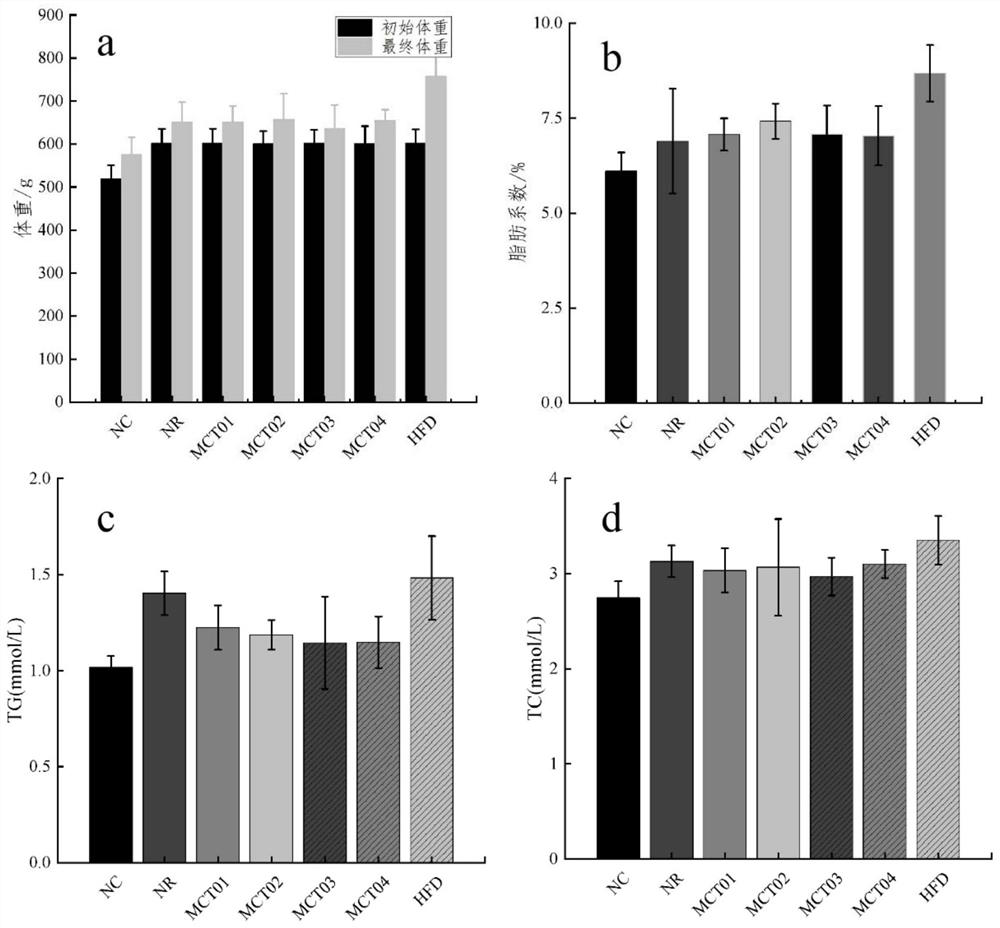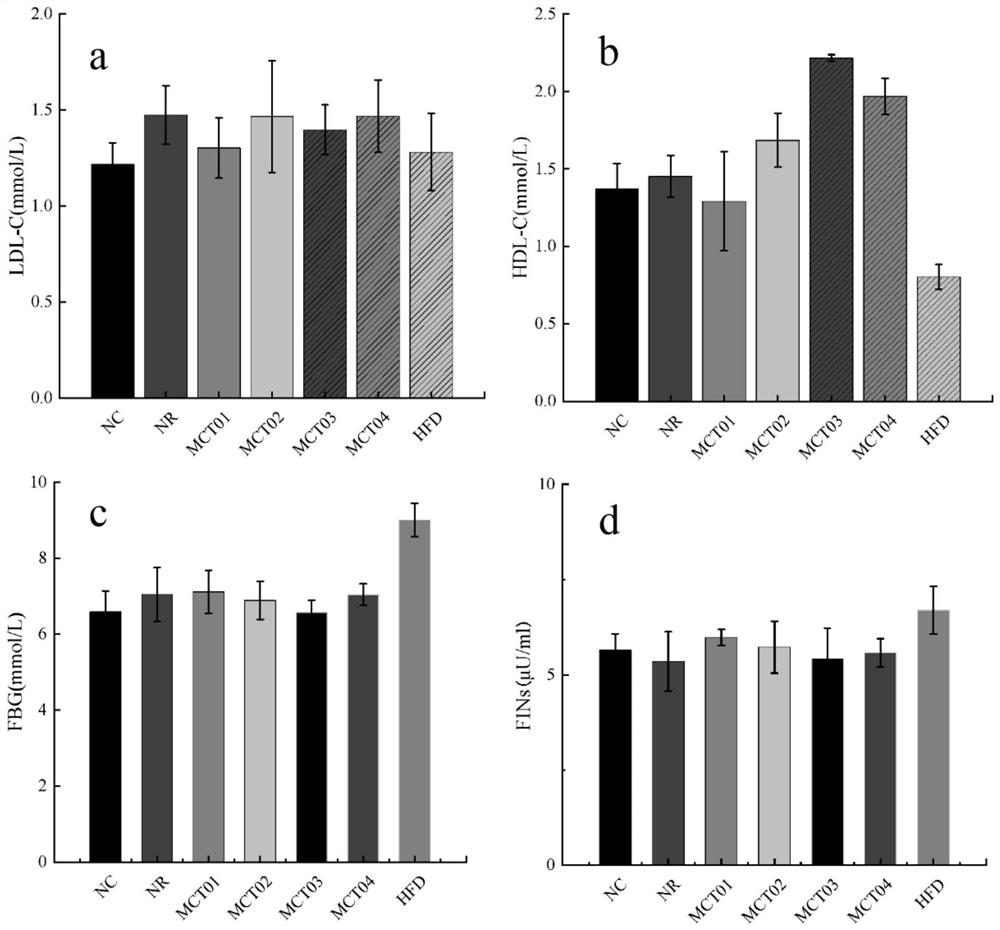Caprylic/capric acid-lauric acid medium-carbon chain oil and preparation method and application thereof
A medium-carbon chain oil and lauric acid technology, which is applied in the direction of fatty acid esterification and fermentation, can solve the problems of inability to convert functional fatty acids, high production energy consumption and production costs, and inability to provide functional fatty acids, so as to improve glucose and lipid metabolism Disorders, significant social benefits, effects on improving health and living standards
- Summary
- Abstract
- Description
- Claims
- Application Information
AI Technical Summary
Problems solved by technology
Method used
Image
Examples
Embodiment 1
[0036] The fatty acid composition and distribution of the camphor tree seed kernel oil used are shown in Table 1. According to the mass ratio of caprylic acid and camphor tree seed oil to be 0.3, 0.4, 0.5, 0.6, take appropriate amount of caprylic acid and camphor tree seed kernel oil respectively in different esterification reactors, and weigh 10% (w / w) of the mixed oil quality Add lipase Staphylococcus caprae lipase. Magnetic stirring, the reaction temperature is 40°C, and the reaction time is 4h. After the binary transesterification reaction, lipase is separated for repeated use, and free fatty acids such as lauric acid are separated to obtain a series of caprylic acid and capric acid lauryl with the mass ratios of caprylic acid and camphor tree seed oil being 0.3, 0.4, 0.5, 0.6 respectively Acid medium carbon chain oil, determine its fatty acid composition and freezing point. The solidification points of the series of caprylic acid, capric acid and lauric acid series medi...
Embodiment 2
[0069] According to caprylic acid and camphor tree seed oil mass ratio being 0.5 respectively, take by weighing 4 parts of mixed oils and fats consisting of camphor tree seed kernel oil of 100g and 50g caprylic acid respectively in 4 reactors of the same specification, and weigh 10% of the mixed oil quality respectively % (w / w) Add immobilized lipase Novozyme 435, immobilized lipase Staphylococcus caprae lipase, immobilized lipase Lipozyme RM IM, immobilized lipase Lipozyme TL IM in 4 reactors. Binary transesterification reaction conditions are: magnetic stirring (stirring bar 30mm * 10mm, rotating speed 100rpm), reaction temperature selects the optimal temperature recommended by each lipase, respectively (immobilized lipase Novozyme 435, immobilized lipase Lipozyme RM IM , immobilized lipase Lipozyme TL IM) at 60°C, (immobilized lipase Staphylococcus caprae lipase) at 40°C, and the reaction time was 4h.
[0070] After the binary transesterification reaction is finished, the b...
Embodiment 3
[0074] According to octanoic acid and camphor tree seed oil mass ratio is respectively 0.5, takes by weighing the mixed grease that the camphor tree seed kernel oil of 100g and 50g octanoic acid are formed in the reactor, and weighs 5%, 10%, 15%, 20% of mixed oil quality respectively %, 25% add lipase Staphylococcus caprae lipase. The conditions for the binary transesterification reaction are: magnetic stirring (stirrer bar 30 mm×10 mm, rotational speed 100 rpm), reaction temperature 40° C., and reaction time 4 h.
[0075] After the binary transesterification reaction is finished, the binary transesterification catalyst is separated for repeated use, and free fatty acids such as lauric acid are separated to obtain the caprylic acid capric acid lauric acid medium carbon chain with a mass ratio of caprylic acid and camphor tree seed kernel oil of 0.5 Oil, Determination of Fatty Acid Neutralization Distribution in Medium Carbon Chain Oils of Caprylic Capric Lauric Acids. The eff...
PUM
 Login to View More
Login to View More Abstract
Description
Claims
Application Information
 Login to View More
Login to View More - R&D
- Intellectual Property
- Life Sciences
- Materials
- Tech Scout
- Unparalleled Data Quality
- Higher Quality Content
- 60% Fewer Hallucinations
Browse by: Latest US Patents, China's latest patents, Technical Efficacy Thesaurus, Application Domain, Technology Topic, Popular Technical Reports.
© 2025 PatSnap. All rights reserved.Legal|Privacy policy|Modern Slavery Act Transparency Statement|Sitemap|About US| Contact US: help@patsnap.com



